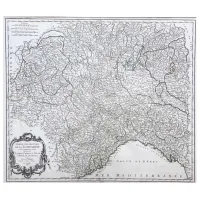De Vaugondy Gilles Robert Western Lombardy Savoy Piedmont Milan Genes Plaisance from the 18th century
Luxury antiques
SKU: ANT-A1032
See other products from category Antique prints or from manufacturer Antyki with shipping within 24 hours
Description
De Vaugondy Gilles Robert Western part of Lombardy Savoy Piedmont Milan Geneva Plaisance etc. 1760. The map was included in the "Atlas Universel," published in 1757 by Gilles Robert de Vaugondy, which also features another map depicting the eastern part of Lombardy; together, both maps form one large table covering northern Italy. In the introduction to the atlas, the author states that he used various sources in creating the maps; in particular, this Milanese map comes from the corresponding map of the State of Milan made in 1703 by Giulio Carlo Frattino. The engraving has a central vertical crease and is in excellent condition. At the bottom is the name of the engraver Guillaume Delahaye (1725-1802) from the famous Parisian family.
Beautiful antique furniture and accessories can be an excellent idea for decorating our interiors. Today, there are more and more enthusiasts of high-quality old products that have a specific character and soul. It's a nod to the history, creation, and design of traditional and timeless furniture. There are many different styles in antique furniture, each with its distinctive features.
There are many different styles characterizing antique furniture, but we can distinguish a few of the most important ones. Eclectic furniture belongs to the 19th century, which is marked by the reigning Biedermeier style. Its variations in the early years of this century include antique Neo-Gothic, Gothic, Rococo, Louis Philippe style, and finally, the English Victorian style. By the end of the century, these styles transition into pseudo styles of Classicism, Renaissance, and Baroque.
Beautiful Empire-style furniture dates from the period between the late 18th and early 19th centuries. It all originated from the reign of Napoleon, where significant similarities and references to Roman and Greek decorations were imposed.
Classicist furniture is the Louis XVI style, which also strongly references ancient architecture. Interesting and noteworthy are all antique products in the Rococo and Louis XV styles. Next is Baroque, whose name comes from the Portuguese barocco – which translates to an irregularly developed pearl. These were very representative pieces of furniture meant to literally ooze glamour and play a significant role in luxury. Exceptional, selectively used materials were employed to further emphasize the lofty tone of these products.
Today, we can observe how the Baroque style has had a significant influence on today's classic furniture, which is designed with great similarity to the past era. Another significant style is the Renaissance, which flourished in the 15th and 16th centuries and also left a large mark on the art of furniture making. Renaissance style was quite heavy and massive. Brown stains were used, as well as cornices, strong plinths, and bas-reliefs. It can certainly be said that these were quite specific products, but they offered many new possibilities, such as the construction of sideboards or generally broadly understood chest furniture. Here, too, there was an interest in mythology and ancient times, so supports or legs took on animal forms.
Lion paws, eagle heads – these are common sights in the Renaissance style. Currently, many global brands recreate such furniture, taking examples from Italian or French creators. This is a manifestation of admiration and care for the history of the most beautiful Renaissance antiques. It is important to remember that in every country, furniture making was perceived differently, so each style in a given country had its own distinct character. This is very important, especially when searching for the right luxury antique for your interior.
The most important aspect of stylish antique furniture is originality. And this is ultimately crucial from the client's perspective, as there are many counterfeits circulating on the market. Luxury Products provides a document confirming the product's compliance with the actual description and photo. At your disposal, we have art appraisers, historians, and experts from around the world.
Attributes / Details
| SKU | ANT-A1032 |
| Manufacturer | Antyki |
| Model | A1032 |
| Size | Height: 47.7 (68.5) cm Width: 55.5 (76.5) cm Depth: 2 cm |
| Wiek | XVIII |
| Rok | 1700 |
| Destiny | Do biura i gabinetu |
See catalog
Reviews
No reviews for this product.













